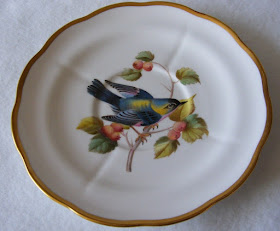 |
| Dessert plate, bone china (detail) Audubon's Birds featuring Morton's Finch |
 |
| 5 different Spode part dessert services c1800-1828 |
Many of these services were handpainted. Each piece would feature a different subject as the centre design. Once the service was complete it would look spectacular with many, many plants or many, many birds often derived from publications of the time, such as Curtis's Botanical Magazine. The flower subjects and the bird subjects were usually named on the backs of the pieces, painted or printed in beautiful script.
 |
| Cream/sugar tureen stand, featuring 'Pine Grosbeak', pattern 1979 c1814 |
 |
| Handpainted backstamp on cream/sugar tureen stand, pattern 1979 |
 |
| Icepail, Lady Staffords shape, pattern 2114 c1820 |
 |
| Spode catalogue page, Audubon Birds 1959 |
On the Special Collections pages of Lehigh University, USA, you can find out more about this book including:
'Measuring 39.5" x 29.5", Birds of America has long been recognised as one of the greatest bird books of all time. Audubon, a self-taught ornithologist and talented artist, researched his specimens in their natural habitats, hunting them to secure their likenesses with brush on paper. His innovative methods of wiring them into position enabled him to sketch and paint elusive specimens, thus contributing to his accuracy.
Audubon supplied his publisher with life-size paintings that were transformed into copperplate etchings and printed in black on white paper. Each plate was then meticulously hand-coloured by Robert Havell's staff according to Audubon's specifications. In many cases, Audubon supplied the birds alone, leaving the background to either his field assistants or Havell. Over 1,000 birds appear on 435 plates, typically bound into four volumes, each with its own title page.'
Copper plates were engraved by the Spode engravers for the 20th century pattern to be produced by the pottery transfer printing process. In this case though the copper plates were engraved the 'right way round'. For the book the copper plates would have been engraved 'back to front'.
Click HERE> to explore Lehigh University's wonderful pages.
 |
| Frontispiece from Lehigh University Special Collections |
 |
| Red-shouldered Hawk |
 |
| Spode catalogue page Rhododendron pattern 1959 |
Spode designer Harold Holdway* recalled that he had access to a copy of Audubon's 'Birds of America' which belonged to Ronald Copeland and so was able to use this to produce the pattern for American customers. The birds were adapted from Audubon's book to fit the ceramic shapes and were not direct copies of the ornithological subjects.
 |
| Spode catalogue page, Audubon Birds 1961 |
Spode produced different versions and different shapes of the Audubon Birds pattern. Each version of the pattern was allocated its own unique pattern number and entered into the pattern books. This meant no confusion was made when a customer ordered a particular version. One of the most well-known versions of the pattern was introduced in 1941 on Hamburg shape with pattern number Y6466 and continued in production for many years.
 |
| Backstamp for a coffee saucer featuring a Bobolink, early 1970s |
 |
| Soup saucer, pattern Y6466 featuring Black-throated blue warbler, early 1970s |
 |
| Backstamp for the soup saucer above, early 1970s |
 |
| Audubon's Black-throated blue warbler published 1827 -1838 |
Below are listed the bird subjects used on the various pieces of tableware for Spode's pattern. They are listed as recorded at Spode but I believe some have been renamed and reclassified since the publication of Audubon's Birds of America, some may not exist and some may be misspelt.
Plates - 10 inch and 9.5 inch
1. Western Tanager
2. Red Eyed Vireo
3. Canada Jay
4. Chestnut Backed Chickadee
5. House Finch
6. Lazuli Bunting
7. Arkansas Kingbird
8. Audubon's Warbler
9. Bohemian Waxwing
10. Scissor Tailed Fly catcher
11. Maynard's Cuckoo
12. Yellow Throated Warbler
Teacup, Coffee Cup, Soup Cup
1. Common Redpoll
2. Dickcissel
3. Bartram's Vireo
4. California Jay
5. Black Capped Chickadee
6. Tennessee Warbler
7. Painted Bunting
8. Northern Shrike
9. Brewer's Blackbird
10. Cape May Warbler
11. Indigo Bunting
12. Bullock's Oriole
Plate 8 inch, Soup plate 8 inch, Soup saucer, Dish 12.75 inch, Baker dish, Square Salad Bowl
1. Townsend's Solitaire
2. Myrtle Warbler
3. Crested Flycatcher
4. Morton's Finch
5. Passenger Pigeon
6. Golden Winged Warbler
7. Blue Grosbeak
8. Least Flycatcher
9. Band-Tailed Pigeon
10. Black Throated Blue Warbler
11. Sage Thrasher
12. Lazuli Bunting
Plate 6.5 inch, Coffee saucer, Tea saucer
1. White Throated Sparrow
2. Pine Warbler
3. Maryland Yellow Throat
4. Blue Headed Vireo
5. Bobolink
6. Cedar Waxwing
7. Clay Coloured Sparrow
8. Cuviers Regulus
9. Ruby Crowned Kinglet
10. Magnolia Warbler
11. Parula Warbler
12. Chestnut Sided Warbler
A series of 6 'Presentation Plates' on Hamburg shape, individually boxed, were produced in the 1970s. There is no information as to which 6 centres were used but probably taken from those for the 10 inch plate.
 |
| Leaflet for 'Presentation Plates'. (The orchid is incorrectly named) 1976 |
